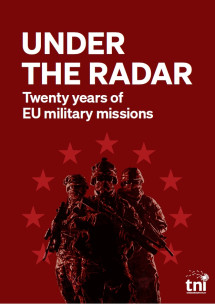The Impact of Climate Change on Peace: the Great Forgotten Issue
Share this News in Facebook and Twitter!
The Impact of Climate Change on Peace: the Great Forgotten Issue
“For hundreds of years, wars have been conducted to obtain access to scarce resources such as land, water or minerals. Such conflicts are among the gravest dangers in today’s world, especially given that most of the world’s big powers possess nuclear weapons. Given the dwindling resources of our planet (peak oil, climate change…) and the growing consumption due to an increasing population and a rapacious economic system, new resource conflicts are likely to appear on a much larger scale” (International Peace Bureau)
The COP 23, which has been taking place since November 6th in Bonn, is therefore the occasion to find out, to which degree climate and peace issues are intertwined.
“The environment has long been a silent casualty of war.” (Ban Ki-moon)
From the US bombed Iraq of missiles containing depleted uranium during the Gulf War to the oil wells set alight by the Islamic State, wars have systematically impacted dramatically the environment. But this is only a part of the problem. The whole military-industrial complex has a huge environmental cost. The simple maintenance of standing armies causes a big threat to the environment; for instance, the US Department of Defence, alone, is the largest consumer of fossil fuels of the country and produces the same CO2 emission than Denmark.
In addition, it is now widely recognized that climate change affect and can exacerbate factors that increase the risk of armed conflict, such as resources scarcity, worsening livelihood conditions and economic hardship. For instance, and in addition to the social and political causes, the Darfur crisis has started as an ecological crisis, at least partly due to climate change. It has been shown that in context of vulnerability, such as war or post-conflict situation, the capacity for affected populations to adapt to climate change is considerably reduced. Climate change thus indirectly fuels violent conflict that, in turn, reduces the capacity to adapt to climate change.
Let’s stand for a Climate of Peace!
It’s time to break this vicious circle and to turn it into a virtuous one. This is why we are calling to reallocate military expenditure to fund human and environmental needs. For instance, funding green technology and helping to deal with climate change consequences would represent only 8.3% of high-income developed countries’ military spending. Similarly, the GCOMS campaign calls to a conversion of the military industry into a civilian-oriented economy; and precisely, green economy is a perfect area to do so. A striking example is a Danish shipyard company which being bankrupt was converted to make windmills.
Moral of the story: the company not only kept all the former shipyard workers but also doubled its initial workforce and is now one of the world’s leader exporters of windmills. Today, one of the biggest challenges is to avoid falling into the trap of the securitization – or militarization – of climate change. Indeed, militarization fuels the proliferation of weapons and normalizes the use of armed and military force in conflicts that affect the environment, which in turn has an extremely negative impact on peace. Rather than boost their military spending to secure their economic interests with actions that spoil the environment, States must develop diplomatic, legal and peaceful solutions through which such conflicts can be mediated without bloodshed, human rights can be guaranteed, and Earth can be protected and preserved.



